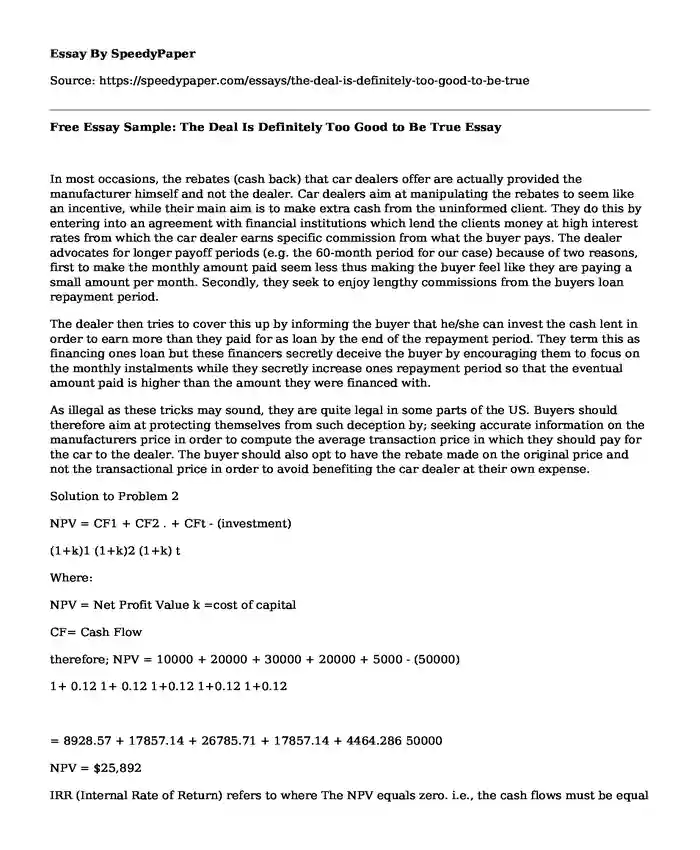In most occasions, the rebates (cash back) that car dealers offer are actually provided the manufacturer himself and not the dealer. Car dealers aim at manipulating the rebates to seem like an incentive, while their main aim is to make extra cash from the uninformed client. They do this by entering into an agreement with financial institutions which lend the clients money at high interest rates from which the car dealer earns specific commission from what the buyer pays. The dealer advocates for longer payoff periods (e.g. the 60-month period for our case) because of two reasons, first to make the monthly amount paid seem less thus making the buyer feel like they are paying a small amount per month. Secondly, they seek to enjoy lengthy commissions from the buyers loan repayment period.
The dealer then tries to cover this up by informing the buyer that he/she can invest the cash lent in order to earn more than they paid for as loan by the end of the repayment period. They term this as financing ones loan but these financers secretly deceive the buyer by encouraging them to focus on the monthly instalments while they secretly increase ones repayment period so that the eventual amount paid is higher than the amount they were financed with.
As illegal as these tricks may sound, they are quite legal in some parts of the US. Buyers should therefore aim at protecting themselves from such deception by; seeking accurate information on the manufacturers price in order to compute the average transaction price in which they should pay for the car to the dealer. The buyer should also opt to have the rebate made on the original price and not the transactional price in order to avoid benefiting the car dealer at their own expense.
Solution to Problem 2
NPV = CF1 + CF2 . + CFt - (investment)
(1+k)1 (1+k)2 (1+k) t
Where:
NPV = Net Profit Value k =cost of capital
CF= Cash Flow
therefore; NPV = 10000 + 20000 + 30000 + 20000 + 5000 - (50000)
1+ 0.12 1+ 0.12 1+0.12 1+0.12 1+0.12
= 8928.57 + 17857.14 + 26785.71 + 17857.14 + 4464.286 50000
NPV = $25,892
IRR (Internal Rate of Return) refers to where The NPV equals zero. i.e., the cash flows must be equal to the project costs
Therefore; 10000 + 20000 + 30000 + 20000 + 5000 - (50000) = 0
1+ IRR 1+ IRR 1+ IRR 1+ IRR 1+ IRR
Multiply by (1+ IRR) on each sum and on both sides
= 10000+ 20000 + 30000 + 20000 + 5000+ 50000(1+IRR) = 0
85000-50000 - 50000IRR = 0
35000 - 50000IRR =0
IRR = 35000 = 0.7
50000 IRR = 70%
Yes, I would, the IRR (70%) is higher than the hurdle rate (12%)
References
Ross Westerfield; Corporate Finance 6the edition
D.Jobber; Selling and Sales Management
Jurgen Appelo; Management 3.0: Leading agile developers
Peter F. Drucker; The Practice of Management
Cite this page
Free Essay Sample: The Deal Is Definitely Too Good to Be True. (2019, Oct 04). Retrieved from https://speedypaper.net/essays/the-deal-is-definitely-too-good-to-be-true
Request Removal
If you are the original author of this essay and no longer wish to have it published on the SpeedyPaper website, please click below to request its removal:
- Free Essay: Nursing School Personal Statement
- Literature Essay Example
- Employee Retention Essay Sample in HR Management
- Essay Sample on Political Editorial Cartoons
- Paper Sample for Free: Personal Traits of Successful Entrepreneurs
- Essay Sample on the Meaning of Progress and Development Discussion
- Impact of Birth Order on Long Term Personality Traits of Individuals - Paper Example
Popular categories





